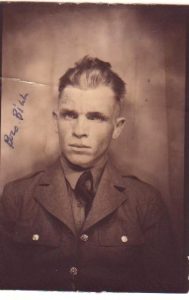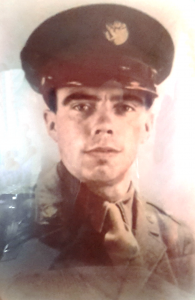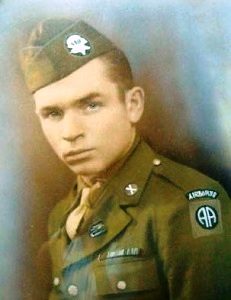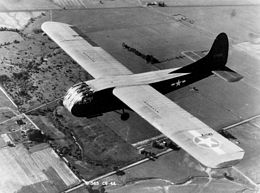Remains of two WWII soldiers identified in Holland and Belgium
Seventy-five years after the war DNA analyses bring two missing soldiers home.
This year brought the good news that DNA analyses solved the question who were resting in two ‘Unknown’ graves at the American military cemeteries ‘Henri Chapelle’ in Belgium and ‘Margraten’ in the Netherlands. Scientific DNA analyses proved that these are the remains of Pfc Clifford Mills from Troy (Indiana) and Pvt. William Hedtke from Iola (Wisconsin).

Both belonged to the 319th Glider Field Artillery Battalion (GFAB) of the 82nd Airborne Division, and both were missing in action since Septemberm18, 1944, after their ‘Waco’ glider landed near the German village of Zyfflich, on the second day of Operation Market Garden.
What happened there was a tragedy because all gliders were supposed to land near the Dutch town of Groesbeek, two or three miles from Zyfflich, on the other side of the Dutch-German border. However, on the second day of the airborne landings, the official landing zone was already crowded with other gliders and equipment.
So several glider pilots decided to land two miles further to the north, in the empty fields near Zyfflich, just beyond the Dutch-German border. But what they did not know, was that Zyfflich was defended by experienced and battle-hardened German paratroopers, the elite ‘Fallschirmjäger’. These were in the neighborhood for rest and refitting after heavy combat in France and Belgium, and they came into action immediately after the first American airborne landings, the previous day.
According to German records, some 20 American gliders landed near Zyfflich, of which seven belonged to the 319th GFAB. The other 13 gliders belonged to other units, like the 320th GFAB, the sister unit of the 319th.

All these gliders were immediately attacked and destroyed by the German paratroopers, many by anti-aircraft fire while they were still airborne. The flimsy ‘Waco’ glider was made of thin steel tubing, wood and doped waterproof canvas that was highly combustible. American soldiers called the ‘Waco’ a ‘flying matchbox’ and many gliders crashed burning in the fields around Zyfflich, instantly killing or wounding the pilot and soldiers on board. The legendary war reporter Walter Cronkite flew into combat in a ‘Waco’ glider that same day, together with soldiers of the 101st Airborne Division. He called it ‘the most frightening experience in my life’, although he was an experienced civilian glider pilot who owned his own glider before the war.
According to German records, 31 American officers and men were taken prisoner at Zyfflich on the second day of Market Garden, but a great number were killed in the battle that ensued after the landing. The ‘After Action Report’ of the 319th GFAB indicates that seven officers and 45 enlisted men were missing on that day, of which only two officers and two enlisted men escaped from the area and made it back to the American lines.
After the battle, the German army didn’t bother to clear the area and bury the many human corpses, but instead, Zyfflich and its low lying surroundings were evacuated and flooded to create a defensive line against the American troops.

In April 1945 the Canadian army entered the deserted area and buried all human remains that they found. Identification was left to the American army, which searched the whole area several times for unmarked graves, during the years after the war. Eventually, all missing personnel of the 319th GFAB were identified with the exception of four: Capt. John Doherty, the Battalion Surgeon (from Buffalo; NY); the ‘medic’ corporal Raymond Lane (from Kentucky) and the privates Clifford Mills and William Hedtke.
Fortunately for their families, the remains of the last two are now identified and Clifford Mills is already re-buried next to the grave of his wife in Troy (Indiana). The remains of William Hedtke will be re-buried with military honors at Arlington National Cemetery, sometime during May next year. That is a fitting honor for a brave soldier, for the Canadians found his remains near the original landing zone of the 82nd Airborne, some three miles from where his glider landed. Apparently William Hedtke managed to avoid imprisonment by the Germans and found his own way back to the American lines where he was evidently killed in action.
However, the fate of John Doherty and Raymond Lane is still a mystery. One of the soldiers who was taken POW at Zyfflich declared after the war that he saw how the Germans freed them from their crashed glider. But after that, all information is lacking. Doherty and Lane were easily identifiable as medical personnel by the red crosses on their helmets, and medical personnel was in urgent demand in the third year of the war. So maybe the German army forced them to work in their own field hospitals somewhere in Europe.
And the search continues, also 75 years after the war. During the past years volunteers from the Netherlands, Belgium, Luxembourg, and France have set up the ‘Fields of Honor Database’ that collects all available life stories and pictures of the WWII soldiers who rest in the American military cemeteries or whose names are on the Walls of the Missing, in the Netherlands, Belgium, Luxembourg and France. Most of these volunteers also have adopted such graves and names and they keep in contact with the families in the US. For more information about this impressive effort check out fields of honor database.
Feature Photo: (Wikipedia) The Waco Combat Glider was specially designed by the Waco Aircraft Company for the transportation of airborne troops and their equipment. It was towed by a motorized transport plane (usually a Dakota C-47) to the designated landing area, where the pilot released the towing line and descended to the target. The Waco was 49 feet long, with a wingspan of 84 feet and a maximum take-off weight of 7.500 lbs. It could carry a pilot, a co-pilot and 13 troops with their equipment. Or two pilots and a jeep or loaded trailer with four persons. Or two pilots and a 75 mm howitzer with a crew of three and ammunition. During the war 13.900 Waco’s were built by 16 contractors, with the Ford Motor Company as the most important and cheapest supplier: 4.190 units at $ 14,891 each.
Note: The author has adopted the name of Capt. John Doherty on the Wall of the Missing at Margraten Cemetery in the Netherlands. He also adopted the grave of 2Lt. Rodney Renfrew at the Henri Chapelle Cemetery in Belgium. Rodney Renfrew came from Coshocton (Ohio) and was a forward artillery observer of the 319th GFAB. He was KIA on 10 February 1945 in Germany, only 22 years old.

René van Slooten is a leading ‘Poe researcher’, who theorizes that Poe’s final treatise, ‘Eureka’, a response to the philosophical and religious questions of his time, was a forerunner to Einstein’s theory of relativity. He was born in 1944 in The Netherlands. He studied chemical engineering and science history and worked in the food industry in Europe, Africa and Asia.The past years he works in the production of bio-fuels from organic waste materials, especially in developing countries. His interest in Edgar Allan Poe’s ‘Eureka’ started in 1982, when he found an antiquarian edition and read the scientific and philosophical ideas that were unheard of in 1848. He became a member of the international ‘Edgar Allan Poe Studies Association’ and his first article about ‘Eureka’ appeared in 1986 in a major Dutch magazine. Since then he published numerous articles, essays and letters on Poe and ‘Eureka’ in Dutch magazines and newspapers, but also in the international magazines ‘Nature’, ‘NewScientist’ and TIME. He published the first Dutch ‘Eureka’ translation (2003) and presented two papers on ‘Eureka’ at the international Poe conferences in Baltimore (2002) and Philadelphia (2010). His main interest in ‘Eureka’ is its history and acceptance in Europe and its influence on philosophy and science during the late 19th and early 20th centuries.

